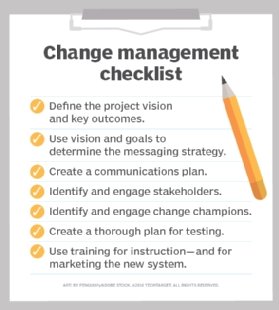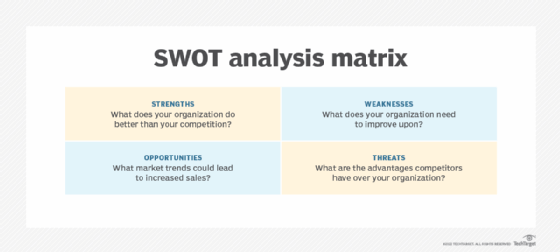steering committee
What is a steering committee?
A steering committee comprises a group of high-ranking IT professionals who provide guidance and strategic direction to an organization or organizational segment. The steering committee is responsible for ensuring that the organization's operations align with its goals and objectives. For example, the steering committee plays a vital role in ensuring that all IT projects support and drive the organization's business goals and objectives. This involves decision-making, oversight and strategic planning.
What are the steering committee's roles and responsibilities?
The steering committee often creates working groups with select subject matter experts. They are responsible for choosing the right experts to complete a project. They can also propose and approve changes to a project's scope. However, projects must be approved by the steering committee to ensure the changes align with the project's aim. Many steering committees create project charters to hold project teams accountable.
Other possible functions and objectives of an IT steering committee include the following:
- Setting the direction for an organization's IT initiatives.
- Developing an IT project business case.
- Prioritizing projects based on investment, resource availability and alignment with business goals.
- Encouraging a collaborative work environment driven by collaboration tools.
- Overseeing projects and monitoring progress toward goals.
- Controlling scope and resolving conflicts.
- Approving and overseeing budgets.
- Guiding change management, including approving changes to the project's scope and managing the impact of these changes.
- Managing risk by identifying potential risks and formulating a plan to mitigate them.

Who needs a steering committee?
The decision to establish an IT-focused steering committee can depend on several factors. Steering committees are usually beneficial for larger organizations with complex IT infrastructure -- companies that rely heavily on IT for daily operations. They also play a key role in enterprises that need to navigate IT-related regulatory compliance. Organizations starting their digital transformation journey also benefit from a steering committee that can manage the proposed IT infrastructure changes.
The need for an IT steering committee is definitely not exclusive to these situations. Smaller organizations or those that do not rely heavily on IT might still find a steering committee helpful in guiding their IT strategy and managing their IT resources effectively. Ultimately, the decision depends on each organization's specific circumstances and needs.
What is a steering committee in project management?
A steering committee in project management, similar to IT, is a group of high-level stakeholders and experts who guide key project initiatives. They are responsible for the project at a strategic level. Project management steering committee members typically include executives and senior leaders equipped to make decisions on the organization's behalf. A steering committee plays a critical role in ensuring project success by setting the strategic direction and enabling decision-making.
What projects require a steering committee?
Although not every project needs a steering committee, it can be highly beneficial for certain types of projects and scenarios, such as the following:
- Large-scale projects that span multiple business units and departments.
- Long-term projects that demand governance and oversight.
- High-risk projects with technological and compliance challenges.
- Projects with significant resource commitments.
- Cross-functional projects with multiple departments or disciplines in an organization.
- Projects with significant stakeholder involvement.
- Technically or organizationally complex projects.
- Projects of strategic importance.
A steering committee can be helpful because it can act as a central point of communication and decision-making. A steering committee often is also charged with ensuring alignment with broader business and organizational objectives, and that discipline can be beneficial.
What is a steering committee meeting?
A steering committee meeting is just what it sounds like. The steering committee members gather to discuss, review and guide a project or organization's strategy, progress and direction.
The main functions of these meetings can include the following:
- Updating or reviewing the status of ongoing projects -- this can include progress toward goals, project timelines and budget adherence.
- Making key decisions regarding the organization's overall strategy, project prioritization, scope changes, resource allocation and risk mitigation.
- Identifying potential risks and issues and developing action plans to mitigate them.
- Developing or revising policies and procedures to guide project or organizational activities.
- Discussing and setting the strategic direction for the project or organization.
- Discussing strategies for keeping stakeholders informed and engaged.
Many organizations have steering committee meetings regularly -- monthly, quarterly or even weekly -- depending on the nature and scale of the project or organization and the urgency of the issues. These meetings are essential for ensuring that the project or organization stays on track toward achieving its objectives.
What are the tools used by steering committees?
A steering committee can use a wide range of tools to help with its strategic decision-making, communication and project oversight responsibilities. These tools help coordinate, track and guide the projects or organizational units they govern.
Popular steering committee tools include the following:
- Project management software. Steering committees often use project management tools, such as Asana, Trello, Jira, Monday.com and Microsoft Project, to track project progress, manage tasks, and oversee timelines and milestones.
- Communication tools. Platforms like Zoom, Microsoft Teams, Slack and email facilitate seamless communication among committee members and other stakeholders.
- Data visualization and reporting tools. Steering committees can use tools like Tableau, Google Looker Studio and Microsoft Power BI to create dashboards and reports for monitoring key performance indicators, project metrics and progress.
- Collaboration and document management tools. Tools such as Google Workspace, Microsoft 365, Microsoft SharePoint and Dropbox are often used for document creation, sharing and collaboration and to ensure that all members have access to the same information.
- Risk management tools. Steering committees can use risk management software, like RiskyProject, to identify, assess and mitigate project risks.
- Budgeting and financial management tools. Finance software like QuickBooks and Oracle NetSuite are popular tools that can help a steering committee track project costs and expenditures and manage budgets.
- Meeting management tools. Steering committee meetings can benefit from software like MeetingBooster to manage agendas, minutes and action items and help keep meetings organized and productive.
Frameworks for strategic decision-making, such as SWOT analysis, decision matrix and cost-benefit analysis, can also help steering committees make informed decisions.

Learn how to assess an organization's needs and implement a technology strategy in this step-by-step guide. Explore the differences of operational technology vs. information technology, and examine different project management tools and strategies. Check out 14 need-to-know tips for digital transformation success and six key steps to develop a data governance strategy.







